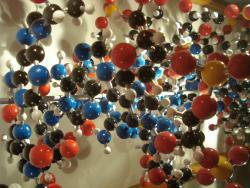Familial Hemiplegic Migraine 1 – Not Always the Same
Familial Hemiplegic Migraine 1 (FHM1) is a rare type of migraine related to the gene locus CACNA1A. Common to FHM1 are speech, visual and sensory disturbances, headache, and loss of coordination (read more about Familial Hemiplegic Migraine here).
 DNA display at Oxford University Natural History Museum Photo courtesy of net efekt |
The fascinating thing about migraine that is familial – that clearly runs in families (although most migraine may be genetically based) is that it’s possible to study genetic connections.
Using these connections,researchers have classified different types of FHM – numbering them 1, 2 and so on (more on types of FHM).
But even within these sub-groups of a specific type of migraine, there are differences. A recent study (published in January) focused on two different CACNA1A mutations – S218L and R192Q. The former, S218L, is associated with more severe versions of FHM.
To understand the study, you need to understand that cortical spreading depression (CSD), a type of "storm" that sweeps across the brain, seems to be key to the progression of migraine symptoms. Not just in FHM, but probably in all types. (more on the science of migraine here)
The finding, in mice, was that those with the S218L mutation were far more susceptible to CSD. It took less stimuli to get one started, and often one "push" would cause multiple CSD events.
For those with the R192Q mutation, just one event was harder to start.
What does this matter? Well, obviously for those with familial hemiplegic migraine this may lead to better diagnosis and treatment.
However, it’s also doing two things for all migraine patients. First, it’s helping us understand more about how cortical spreading depression works. Second, there may be a much wider group of migraineurs that have a similar or identical mutation. Many with more common types of migraine have mutations in the gene locus CACNA1A.
In fact, it’s not only migrainuers we’re talking about. Other disorders may be involved, including those with nystagmus (involuntary movement of the eyeballs) and ataxia (unsteadiness, loss of muscle coordination), and seizures. Head trauma has also been related to this gene mutation. The connection between S218L and the calcium channels are also of interest as the study of calcium channels and migraine is of great interest in current research.
More on this study: High cortical spreading depression susceptibility and migraine-associated symptoms in Ca(v)2.1 S218L mice.
More on FHM1, seizures and head trauma
Electroencephalographic changes and seizures in familial hemiplegic migraine patients with the CACNA1A gene S218L mutation

20 March 2011 @ 1:44 pm
Do you know of any current research studies for familial hemiplegic migraine? Or any charities, organizations, etc. that are trying to raise money for the research?
Thank you!
24 October 2011 @ 5:57 am
I would also be interested to participate in any research studies into FHM. My life is debilitated by these and my son and daughter have both started presenting with them.
My FMH affects my left hand side with dense paralysis and loss of consciousness, followed by days or weeks of confusion, slurring and loss of motor function.
Unfortunatly people don’t know much about them, so even doctors assume it’s a stroke and I get whisked off in an ambulance at the drop of a hat, I only need a bit of facial drooping and I’m getting the blue light treatment. I want my life back, so will do anything to find out how to make this better.